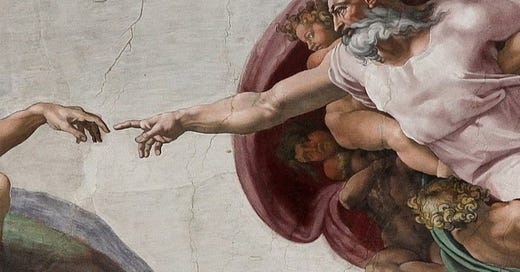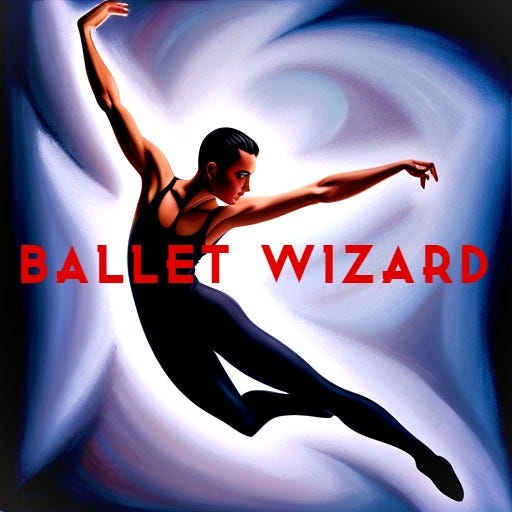Philosophy and the art of allongé
How internal expression becomes the artistic expression of the infinite.
Michelangelo is going to teach you something about allongé.
Allongé translates as elongated, meaning to draw out to a greater length. This is an arm position in ballet in which the dancer is typically in a first or high fifth position and stretches the arm(s) out before closing into another position.
Back to Michelangelo.
When one of the most renowned artists, Michelangelo, drew the ultimate infinite being, God, outstretching his arm to impart the spark of life from His own finger into that of Adam, He did not reach with His arm fully extended. Yet, the space in between them seems to grow infinitely the more you stare at it.
Our human body is not physically capable of growing our arms longer, but we can take Michelangelo’s painting as a great example to see how our finite physical body can seem to grow infinitely on stage. If Michelangelo can paint what seems to be infinite on a two-dimensional ceiling, then we, as three-dimensional artists, should have the advantage.
And on that note…
Allongé into arabesque
In this port de bras series, you have learned how to correctly get into fifth low preparatory position and first position of the arms. Before we learn about fifth high position, we are going to explore allongé, and learn how to actually create an allongé that is long, beautiful, and of course, powerful.
After all, if we’re going to stretch our arms to evoke the infinite, we’re not going to go about it by trying to achieve just a pretty shape.
We will now explore going from first position to arabesque using allongé. After learning this sequence of steps and fundamental principles, your arabesque will be incomparably different. A beautiful line will only be one benefit of learning exactly how to do it.
To start, you must be able to get your arms into first position correctly. You can read it step by step right here.
A step-by-step breakdown
The starting point of stretching your arm to arabesque is first position. The height of the arabesque arms can vary. The arms can be low, in front of the chest, or way up high.
The most basic placement to practice will be an arabesque arm that is parallel to the ground, so you will start there.
Go from first position to arabesque:
You have arrived into first position.
Pick which one of your arms goes front. Typically only one arm is in front for arabesque (unless you are doing some cool ballet like Red Angels by Ulysses Dove, which involves two arms directly in front of you).
Keep your shoulder blades engaged towards the spine, so that your shoulders stay where they are (they will remain still while your arms are moving). The engagement of your rhomboids (the muscles that rotate your shoulder blades) will also keep your shoulder blades stable.
Be careful not to squeeze your trapezius (the muscle that connects from your neck to the top of the shoulder and upper spine and even clavicle) because it disengages your chest. I hope by this point with your new knowledge of port de bras that if your chest is disengaged when you move your arms, you will not only be weak, you will also be engaging in incorrect and painful movement habits.
Keep the rotation of your upper arm extending to arabesque, keeping the pointy part of your elbows up—do not point them to the ground.
As we are going into arabesque, I have to separate the upper arm and lower arm here to explain, but these next two steps should be done at the same time.Upper arm into arabesque: Focus on the path of your elbow here. Imagine that your elbow is a ball, the size of a golf ball floating in the air.
From first position, your elbow will make an arch up and in towards the center of your body without any rotation of the bone.
Lower arm into arabesque: There are two things that happen at the same time.
Extension of the elbow joints.
Pronation (palm down) rotation.
Combine steps 5 and 6 together. While your elbow goes inwards, your forearm goes outward, and your wrist turns palm down. Now you have arrived to the arabesque position.
There’s a lot of details here, I know. Expect a video coming your way soon.
Now the art of it
What makes arabesque arms look long? The easiest answer is that you may literally have long arms, but we’re not all born this way. What can we, people of regular proportions, do to look as long as possible?
If you stretch and lock out every joint that connects one finger to the opposite finger while feeling long, then would you look long? You might feel the longest (maybe physically it could be long), but can that actually translate as allongé, the artform of length?
Let’s get back to Michelangelo’s painting.
When you look closely, the reaching arms of both figures are rather relaxed and not “straight.” Yet it is clear in the line and energy that there is a sense of reaching and stretching out. Even though their arms are not fully stretched out, Michelangelo was able to evoke energy that seems to grow infinitely.
The God figure, from my perspective, is more powerful and stronger than Adam. That strong energy seems to be drawn by keeping God’s arms in front, and almost like He is sending His arm from the center of His chest— the heart. In contrast, Adam’s arms are kept behind his body, his elbow is resting passively on his knee, and his arm seems disconnected from his heart. Which makes sense because this painting represents the moment before God gives life to Adam.
And this is exactly how to extend your arms to allongé in a way that looks long, energetic, and has purpose.
The 4 rules to get long arms
You must connect arms to your heart, and move your arms from your heart.
You must keep arms in front of your body.
You must keep your elbows from dropping down.
You must never extend your joints fully nor hyper-extend.
When you extend your arms fully (hyperextended and locked out), you may feel the full stretch, and that feeling of long does feel good and real. But you may forget as a dancer, would that actually look long on stage? Feeling is important, but that’s simply not enough to transform you into a true artist onstage who is evoking length. When you rely on feelings, you might feel connected to your heart, but too often, it doesn’t translate to the audience. Think of when you would stretch out your arms fully in real life—probably when you are drowning underwater trying to reach for the edge of the pool in desperation. My point is, feelings may not translate to the people watching you.
Instead, you must keep the feeling of “long” more internal. That can be done by not extending your arms (especially your elbows) fully, keeping them more bent that you think. While God gives life to Adam from the power within Him, the power never leaves from within Him. You also must first move your heart before arms, and never leave the connection at the center of your chest—heart. In allongé, you cannot give all your power away just to feel infinite. The infinite must remain in you. And ironically, you will actually look more infinite when you dance.
If you are able to keep your arms connected to your heart, then even when you open your shoulders to make your arabesque position (a more flat and open position), your arms should always remain connected to your heart. This is also why you must keep your arms in front of you at all times so that you don’t lose connection to your heart.
The only time to drop your elbows
The artistry of port de bras must be tied with the character you play. Whenever you are performing a character that needs to express a little bit of weakness, then your elbows can drop. Otherwise, your elbows should always be up, and not look like they need to rest on your knees for support.
Some ballet characters require very strong arms e.g. Spartacus, Kitri from Don Quixote, and Rothbart from Swan Lake. Other ballet characters require a little bit of weakness e.g. Aurora from Sleeping Beauty (young girl), Nikiya from La Bayadere (especially in relation to Gamzatti), and usually one of the sub-characters. Usually sub-characters do not point to the infinite because they are not the protagonist of the stories. They’re not meant to be stronger than the person who is telling the main story. And principal characters are the ones that point to something greater than themselves as they carry and tell the story throughout a ballet.
The question, is what does your port de bras tell you about who you are?






